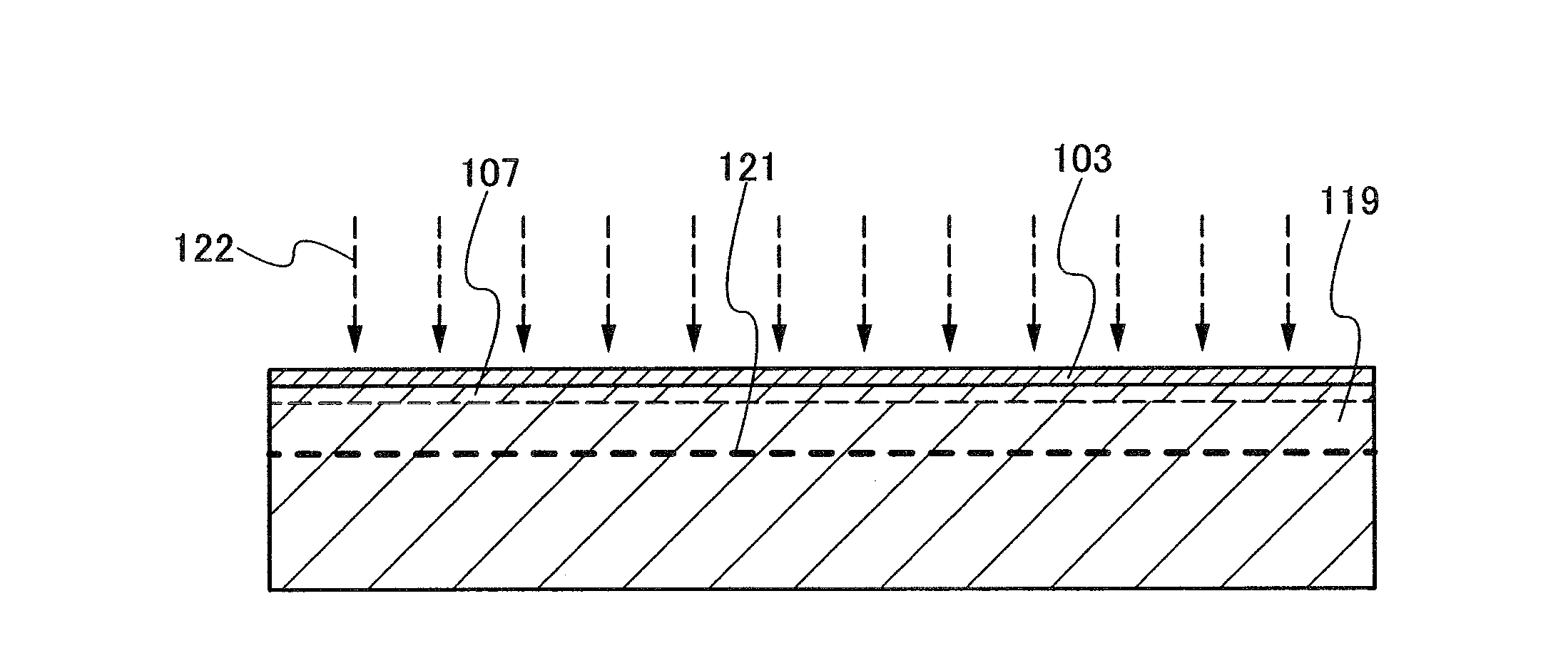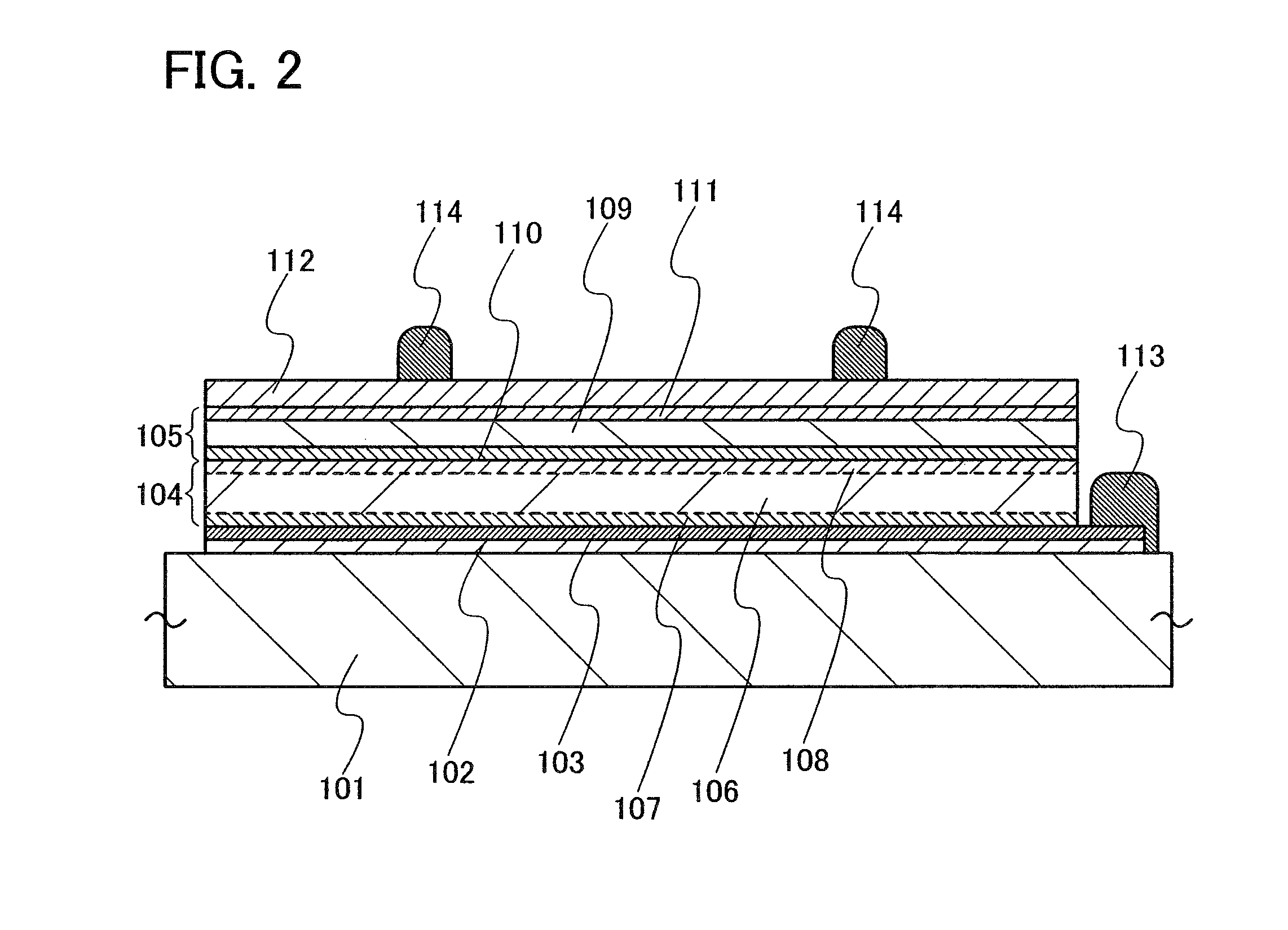Photoelectric conversion device and method for manufacturing the same
a technology of photoelectric conversion and conversion device, which is applied in the direction of basic electric elements, semiconductor devices, electrical equipment, etc., can solve the problems of limited resources effectively used, difficult to produce enough photoelectric conversion devices to meet the demand, and inability to maintain bond strength for a long time, etc., and achieve the effect of effective resource us
- Summary
- Abstract
- Description
- Claims
- Application Information
AI Technical Summary
Benefits of technology
Problems solved by technology
Method used
Image
Examples
embodiment mode 1
[0033]FIG. 1 is a plan view of a photoelectric conversion device 100 of this embodiment mode. This photoelectric conversion device 100 includes a first unit cell 104 and a second unit cell 105 which are fixed to a supporting substrate 101. The first unit cell 104 and the second unit cell 105 include semiconductor junction by which photoelectric conversion is performed.
[0034]The first unit cell 104 is provided with a first electrode on the supporting substrate 101 side and the second unit cell 105 is provided with a second electrode on the surface side. The first electrode is connected to a first auxiliary electrode 113 and a second auxiliary electrode 114 is provided over the second electrode. The photoelectric conversion device 100 of this embodiment mode has a structure in which the first unit cell 104 and the second unit cell 105 are stacked over the supporting substrate 101 having an insulating surface; therefore, positive and negative electrodes are exposed to the same surface ...
embodiment mode 2
[0050]Next, a method for manufacturing the photoelectric conversion device 100 with its cross-sectional structure along section line A-B of FIG. 1 corresponding to the structure shown in FIG. 2 will be described.
[0051]A semiconductor substrate 119 shown in FIG. 5A is a substrate with a shape about a quadrangular shape, cut out from a circular single crystal semiconductor substrate. The shape of a top surface of the semiconductor substrate 119 is not limited in particular; however, the semiconductor substrate 119 preferably has the shape about a quadrangular shape in the case where a supporting substrate which supports a single crystal semiconductor layer is rectangular in shape. The semiconductor substrate 119 is typically single crystal silicon and preferably has its surface polished to have a mirror surface. This is because the semiconductor substrate 119 is disposed in close contact with the supporting substrate with an insulating layer for bonding interposed therebetween. For ex...
embodiment mode 3
[0083]In Embodiment Mode 2, in some cases, due to the formation of the damaged layer 121, crystal defects remain at the surface of the single crystal semiconductor layer 106 which is exposed through the separation of part of the semiconductor substrate 119 shown in FIG. 6B. In those cases, it is preferable that the surface portion of the single crystal semiconductor layer 106 be removed by etching. For the etching, either dry etching or wet etching is performed. Further, in some cases, a rough surface remains in which mean surface roughness (Ra) is 7 to 10 nm and the largest difference in height between peak and valley (P−V) is 300 to 400 nm. The ‘largest difference in height between peak and valley’ in this specification refers to a difference in height between the peak and valley. The ‘peak’ and the ‘valley’ in this embodiment refer to a peak and a valley obtained by three-dimensional expansion of the “peak” and the “valley” defined by JIS B0101. The peak is represented as the hig...
PUM
 Login to View More
Login to View More Abstract
Description
Claims
Application Information
 Login to View More
Login to View More - R&D
- Intellectual Property
- Life Sciences
- Materials
- Tech Scout
- Unparalleled Data Quality
- Higher Quality Content
- 60% Fewer Hallucinations
Browse by: Latest US Patents, China's latest patents, Technical Efficacy Thesaurus, Application Domain, Technology Topic, Popular Technical Reports.
© 2025 PatSnap. All rights reserved.Legal|Privacy policy|Modern Slavery Act Transparency Statement|Sitemap|About US| Contact US: help@patsnap.com



